Rapid, accurate, and comparative differentiation of clinically and industrially relevant microorganisms via multiple vibrational spectroscopic fingerprinting†
Abstract
Despite the fact that various microorganisms (e.g., bacteria, fungi, viruses, etc.) have been linked with infectious diseases, their crucial role towards sustaining life on Earth is undeniable. The huge biodiversity, combined with the wide range of biochemical capabilities of these organisms, have always been the driving force behind their large number of current, and, as of yet, undiscovered future applications. The presence of such diversity could be said to expedite the need for the development of rapid, accurate and sensitive techniques which allow for the detection, differentiation, identification and classification of such organisms. In this study, we employed Fourier transform infrared (FT-IR), Raman, and surface enhanced Raman scattering (SERS) spectroscopies, as molecular whole-organism fingerprinting techniques, combined with multivariate statistical analysis approaches for the classification of a range of industrial, environmental or clinically relevant bacteria (P. aeruginosa, P. putida, E. coli, E. faecium, S. lividans, B. subtilis, B. cereus) and yeast (S. cerevisiae). Principal components-discriminant function analysis (PC-DFA) scores plots of the spectral data collected from all three techniques allowed for the clear differentiation of all the samples down to sub-species level. The partial least squares-discriminant analysis (PLS-DA) models generated using the SERS spectral data displayed lower accuracy (74.9%) when compared to those obtained from conventional Raman (97.8%) and FT-IR (96.2%) analyses. In addition, whilst background fluorescence was detected in Raman spectra for S. cerevisiae, this fluorescence was quenched when applying SERS to the same species, and conversely SERS appeared to introduce strong fluorescence when analysing P. putida. It is also worth noting that FT-IR analysis provided spectral data of high quality and reproducibility for the whole sample set, suggesting its applicability to a wider range of samples, and perhaps the most suitable for the analysis of mixed cultures in future studies. Furthermore, our results suggest that while each of these spectroscopic approaches may favour different organisms (sample types), when combined, they would provide complementary and more in-depth knowledge (structural and/or metabolic state) of biological systems. To the best of our knowledge, this is the first time that such a comparative and combined spectroscopic study (using FT-IR, Raman and SERS) has been carried out on microbial samples.

- This article is part of the themed collection: Surface-enhanced Raman scattering


 Please wait while we load your content...
Please wait while we load your content...